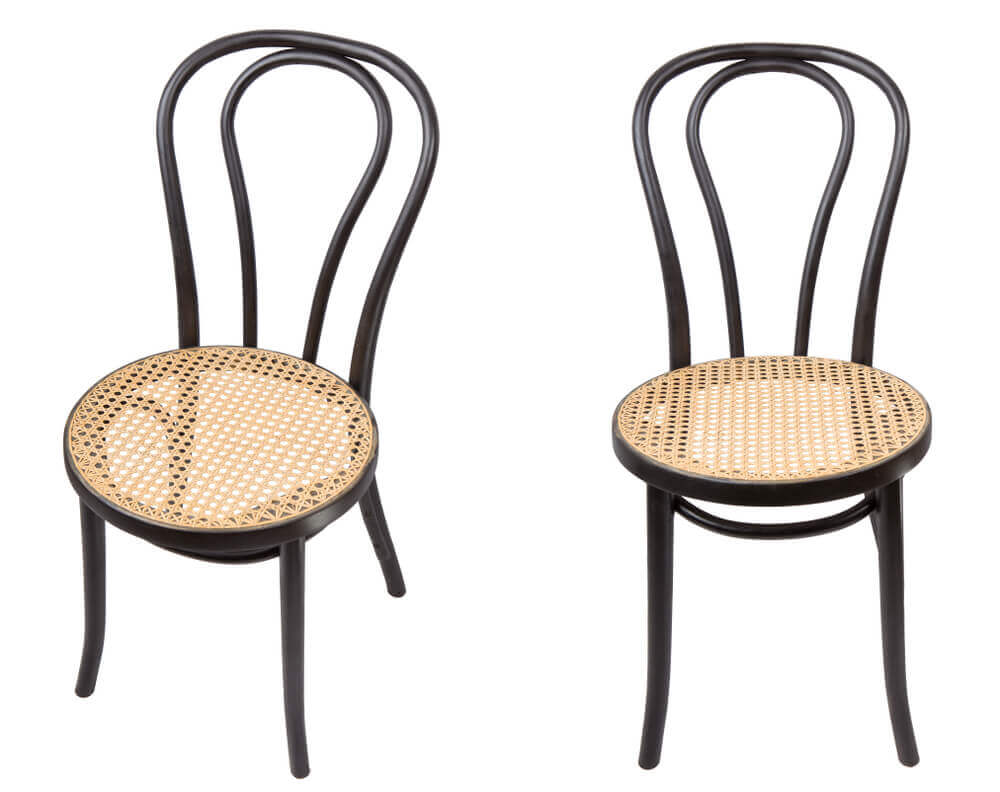Chairs - From Practical to Design Icons

Historically chairs were a solely practical element that slowly became a design icon. We seem them as an everyday item that has always been around.
Chairs might very well have been one of humanity’s best inventions ever. At one point all those years ago, someone realized that we needed a piece of furniture to rest our bodies.
Today, the chair goes above and beyond its original purpose. It provides a seat for us to work, eat or rest. Chairs also represent each time period’s unique identity.
They’ve moved on from being simple everyday objects to collection pieces. Chairs are present everywhere in a home and they’re key elements in interior design.
The origin of chairs

There’s a little controversy surrounding the origins of these popular objects. Most people believe that the Babylonian scribe Ebih-Il first assembled a set of wooden legs and a wooden board. The result was the first chair in history.
But others believe that the chair hails back to the 14th century BC. According to certain stories, the Pharaoh Tutankhamen had a chair among his many processions.
The chair was a symbol of the Pharaoh’s power over his followers. Egyptian chairs were made from ebony, ivory, and gold to convey wealth and power.
These chairs, which were exclusively for the upper class population in those times, flaunted intricate relief and paintings. While chairs appeared frequently in Egyptian paintings, they were only for royalty and wealthy families. Regular citizens, who lacked such privileges, used humble chairs or simply sat on the floor.
While there’s no clear answer, we can conclude that the chair originated around that time period. This item, which is now a design icon, evolved alongside humanity throughout the different periods of history.
A witness to key moments of world history, the chair has and continues to hold great importance.
From the Medieval Ages to today

During the Medieval Ages, when scarcity was prominent, homes usually only had one chair that was reserved for the father of the household. Chairs marked such prestige that they were often used for guests as well. The rest of the household sat on stools, benches, chests, folding chairs or on the floor.
Thanks to ancient manuscripts, we learned that during the 5th century in Spain, people used chairs that featured straight legs and a simple back. The back of the chair was formed by two sticks and a diagonal crossbar that came up from the seat.
During the Renaissance period, people began to upholster their chairs. Pink was the most popular color of all. We can still find and admire these upholstered pieces today.
In 16th-century Spain, chairs began to flaunt elegant shapes with curved posts and carved leather. The king at the time, Philip II, loved chairs and you can still see some examples of his collection at the El Escorial Monastery.
In the Baroque period, which started in the 17th century, chairs varied in models, styles and finishes. The quality of the pieces depended on the wealth of their requester.
Moving on to Modern times, spanning from the end of the 17th century to the 18th century, the chair continued as a power symbol for kings and their thrones. The splendor of a king had a direct link to the woodwork; the more intricate the design, the more powerful was the king.
But in the end of the 18th century, contemporary times saw a change in the purpose of the chair. It moved from displaying opulence to more everyday use, which is how it continues today. A new relationship between architecture and furniture design also began and grew stronger over the years.
Chairs, practical to design icon – the 20th century

The Thonet chair arrived, and delighted, in the 19th century. The chair, a design by Michael Thonet, and its curved shape would be the first in a series. It was a prelude to 20th-century industrial-style chairs.
The Thonet chair took a new spin in the 20th century thanks to industrialization and the use of new materials. The big names in architecture and industrial design left their mark on this time period.
Among them were Adolf Loos, Mies van der Rohe, Charles and Ray Eames, Marcel Breuer, Philippe Starck and Le Corbusier. They designed high-end chairs, with many of them turning into design icons.
Pieces such as Breuer’s Wassily stool, Le Corbusier’s LC4 chaise longue and van der Rohe’s Barcelona chair are great examples.
As you’ve read with us in our brief overview, chairs were once a solely practical piece and are now design icons. Try decorating your home with a classic or modern chair. You can create a somber, harmonious setting that’s full of personality.
Historically chairs were a solely practical element that slowly became a design icon. We seem them as an everyday item that has always been around.
Chairs might very well have been one of humanity’s best inventions ever. At one point all those years ago, someone realized that we needed a piece of furniture to rest our bodies.
Today, the chair goes above and beyond its original purpose. It provides a seat for us to work, eat or rest. Chairs also represent each time period’s unique identity.
They’ve moved on from being simple everyday objects to collection pieces. Chairs are present everywhere in a home and they’re key elements in interior design.
The origin of chairs

There’s a little controversy surrounding the origins of these popular objects. Most people believe that the Babylonian scribe Ebih-Il first assembled a set of wooden legs and a wooden board. The result was the first chair in history.
But others believe that the chair hails back to the 14th century BC. According to certain stories, the Pharaoh Tutankhamen had a chair among his many processions.
The chair was a symbol of the Pharaoh’s power over his followers. Egyptian chairs were made from ebony, ivory, and gold to convey wealth and power.
These chairs, which were exclusively for the upper class population in those times, flaunted intricate relief and paintings. While chairs appeared frequently in Egyptian paintings, they were only for royalty and wealthy families. Regular citizens, who lacked such privileges, used humble chairs or simply sat on the floor.
While there’s no clear answer, we can conclude that the chair originated around that time period. This item, which is now a design icon, evolved alongside humanity throughout the different periods of history.
A witness to key moments of world history, the chair has and continues to hold great importance.
From the Medieval Ages to today

During the Medieval Ages, when scarcity was prominent, homes usually only had one chair that was reserved for the father of the household. Chairs marked such prestige that they were often used for guests as well. The rest of the household sat on stools, benches, chests, folding chairs or on the floor.
Thanks to ancient manuscripts, we learned that during the 5th century in Spain, people used chairs that featured straight legs and a simple back. The back of the chair was formed by two sticks and a diagonal crossbar that came up from the seat.
During the Renaissance period, people began to upholster their chairs. Pink was the most popular color of all. We can still find and admire these upholstered pieces today.
In 16th-century Spain, chairs began to flaunt elegant shapes with curved posts and carved leather. The king at the time, Philip II, loved chairs and you can still see some examples of his collection at the El Escorial Monastery.
In the Baroque period, which started in the 17th century, chairs varied in models, styles and finishes. The quality of the pieces depended on the wealth of their requester.
Moving on to Modern times, spanning from the end of the 17th century to the 18th century, the chair continued as a power symbol for kings and their thrones. The splendor of a king had a direct link to the woodwork; the more intricate the design, the more powerful was the king.
But in the end of the 18th century, contemporary times saw a change in the purpose of the chair. It moved from displaying opulence to more everyday use, which is how it continues today. A new relationship between architecture and furniture design also began and grew stronger over the years.
Chairs, practical to design icon – the 20th century

The Thonet chair arrived, and delighted, in the 19th century. The chair, a design by Michael Thonet, and its curved shape would be the first in a series. It was a prelude to 20th-century industrial-style chairs.
The Thonet chair took a new spin in the 20th century thanks to industrialization and the use of new materials. The big names in architecture and industrial design left their mark on this time period.
Among them were Adolf Loos, Mies van der Rohe, Charles and Ray Eames, Marcel Breuer, Philippe Starck and Le Corbusier. They designed high-end chairs, with many of them turning into design icons.
Pieces such as Breuer’s Wassily stool, Le Corbusier’s LC4 chaise longue and van der Rohe’s Barcelona chair are great examples.
As you’ve read with us in our brief overview, chairs were once a solely practical piece and are now design icons. Try decorating your home with a classic or modern chair. You can create a somber, harmonious setting that’s full of personality.







